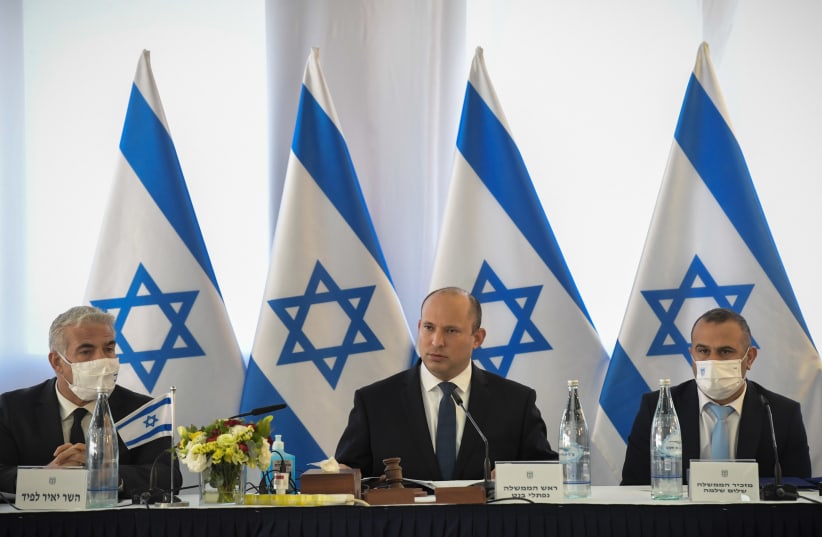Israel’s cabinet is to be commended for passing a NIS 1 billion investment plan on Sunday aimed at significantly developing the Golan Heights. Approved in a festive meeting held at Kibbutz Mevo Hama, the plan calls for doubling the Jewish population there in the next three years, building two new towns, and boosting the local economy.
“The need to strengthen, cultivate and live in the Golan Heights is certainly a principle that unites everyone,” Prime Minister Naftali Bennett told his ministers.
מתחילים יום חשוב ברמת הגולן. pic.twitter.com/LaCKZgBq0h
— Naftali Bennett בנט (@naftalibennett) December 26, 2021
Bennett is right. If there is one issue on which the majority of Israelis agree, it is the Golan. Especially now, as the country is reeling again from another wave of corona, we can all appreciate the rolling Golan hills, the greenery and snow, the water and the wine. We can’t all visit Europe now, but we can go to the Golan to ski, play in the snow, or just admire its pristine beauty.
In his address to the cabinet, Bennett acknowledged the recognition by Donald Trump’s administration of Israeli control of the Golan Heights, adding that “the Biden administration has made it clear that there is no change in this policy.”
Yes, it is true that most of the international community, the far-Left, and many Arab Israelis oppose Israeli sovereignty on the Golan. Their opposition was articulated best by MK Ahmad Tibi: “It doesn’t matter how many cabinet meetings are held on the Golan, it is occupied Syrian territory,” Tibi tweeted.
We would like to remind Tibi that this month marks the 40th anniversary of the Knesset’s passage of the Golan Heights Law, which applied Israeli law to the Golan, captured by Israel from Syria in the defensive Six Day War of 1967.
The new plan, drawn up by a team headed by Prime Minister’s Office Director-General Yair Pines, is to boost the population in the Golan Regional Council and the Katzrin Local Council between 2022 and 2025. Today, 53,000 people live on the Golan: 27,000 Jews, 24,000 Druze, and 2,000 Alawites.
Some of the main points of the decision, according to the official cabinet statement, are worthwhile and worthy of putting on record:
- A future addition of approximately 7,300 residential units in around five years, allocated to include 3,300 units in Katzrin, and 4,065 in the Golan Heights Regional Council.
- The goal of the decision is to double the number of residents on the Golan Heights, including Katzrin, in the coming years, i.e., an additional 23,000 residents in the area.
- An additional 4,000 units in new communities. In the framework of the decision, two new communities (Asif and Matar) will be established, with approximately 2,000 units each (in addition to 7,300 units in the Golan Heights Regional Council and Katzrin).
- NIS 160 million will be invested in improving quality of life. Investments will be made in transportation infrastructure to link the Golan to the center of the country, and to link communities in the Golan Heights Regional Council area to Katzrin.
- The provision of urgent medical care will be upgraded, and the activity of the forward medical switchboard in Katzrin will be expanded.
- NIS 162 million will be invested in local and regional economic development. Tourism infrastructure will be developed centering on the Golan Trail for bicycles. Grants will be provided for entrepreneurs in lodging (including in new facilities) and marketing.
- Research & development and innovation: Agritech will be developed in the area, and the Golan will become the “climate technologies capital.” Impact investments will be made in the region, the food-tech cluster in Kiryat Shmona will be linked to the Golan Heights, etc.
- Unprecedented investment in a plan for developing employment and creating approximately 2,000 jobs on the Golan Heights in the following areas: Agritech, hotels, agriculture, commercial areas, base factories, etc.
- The Golan Heights will become the renewable energy capital. Hundreds of millions of shekels are set to be invested in a solar PPP project, including accumulation on approximately 4,000 dunams in the Valley of Tears.
In the past decade, it has become clearer than ever that the Golan, strategically bordering Syria, must remain in Israeli hands. Its peaceful development is not only vital for Israel, but bolsters hopes for the entire region.
